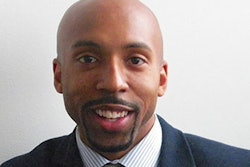With COVID-19 and its mutations still a presence and cold and flu season in full swing, nurses across the nation continue to be pushed to their limits.
In January, nurses from two of New York City’s private hospitals went on strike. Staffing levels were a significant issue in the negotiations.
 The Ohio State University College of Nursing uses its Summer Institute for Future Nurses as a recruiting tool for high school students.
The Ohio State University College of Nursing uses its Summer Institute for Future Nurses as a recruiting tool for high school students.
The federal government projects that more than 203,000 new registered nurse (RN) positions will be created each year from 2021 to 2031, according to the American Association of Colleges of Nursing (AACN). But a November 2022 article in U.S. News and World Report, “The State of the Nation’s Nursing Shortage,” reports that, “Fueled by factors like employee burnout, an aging population and a dearth of training, states across the country are facing a familiar and common problem: a nursing shortage.”
Schools of nursing are working to not only educate future nurses, but also bring more diversity to the profession.
“There are structural, social, and systemic determinates that are barriers to more diversity in the nursing workforce,” says Dr. Shannon B. Smith, associate professor and chair of Claflin University’s Department of Nursing. “Those barriers lead to a lack of access to quality education for our minority students and students from disadvantaged backgrounds.”
Response to the pandemic
In 2022, Claflin, an HBCU institution in Orangeburg, South Carolina, was an AACN Diversity, Inclusion and Sustainability in Nursing Education Lectureship Award Winner. Claflin does not have a traditional four-year bachelor’s degree in nursing science (BSN). Rather, it is known for its RN–BSN program, in which RNs with associate degrees (ADN) can earn their bachelor’s degrees. Claflin also has a master’s program (online except for the clinical portion) and is the only HBCU in South Carolina with a BSN or MSN program.
“RN to BSN enrollment is down across the country [since the onset of the pandemic], and Claflin has experienced that as well,” says Smith. “Some of it is these nurses are working so many overtime hours, they’re so stressed out that school becomes a secondary thought.”
Smith says Claflin nursing faculty have gone above and beyond to offer psychosocial support to the students. This includes multiple phone calls to offer encouragement or simply listen to what those working nurses have experienced personally and professionally. She credits the faculty for creating an environment where students feel safe discussing their concerns while continuing their education with sustained quality.
During the pandemic, faculty at Dominican University, a private Catholic institution near Chicago and another AACN honoree, put together two virtual symposiums about the lack of diversity in healthcare as well as health disparities and inequities that existed prior to COVID-19 and how the pandemic made them more evident. Conversations are ongoing on campus about how to better meet the needs of students, faculty, and staff utilizing a holistic approach, says Dr. Tamara Bland, associate professor and interim dean of the Borra College of Health Sciences and Elizabeth T. MacNeil School of Nursing.
“We’re giving students multiple resources to fit different needs,” Bland says. “We’ve had to be vulnerable about our own burnout as faculty during COVID. That’s showing our authentic selves for students, so they know it’s OK to be vulnerable.”
Diversifying the nursing workforce
“For everyone that we graduate, there’s another provider who can improve patient outcomes for diverse populations,” says Smith, adding that the MSN programs — one for family nurse practitioner and one in nursing leadership — are crucial to increasing diversity in the healthcare workforce in South Carolina.
Dominican University is an Hispanic-Serving Institution. It sponsored a cohort of faculty to participate in an ESCALA program with an eye toward closing the gap in educational access and success for Latinx students. ESCALA works with HSIs to close access and completion gaps.
“We have lots of opportunities here on campus to bring forth and talk about diversity in spaces both private and public,” says Bland. “It is incredible to have minority students have a safe space on campus to talk about issues that affect them — whether it’s political, cultural, or classroom related.”
Bland has also been working with the admissions department on targeted recruitment in specific communities in the Chicago area to reach minority groups. There are ongoing efforts to diversify the faculty so that it mirrors the student population the university hopes to enroll. Although Dominican does not have graduate programs, students who show an interest in becoming nurse educators are engaged after graduation as tutors and encouraged to participate in other activities, thus setting them on the path. She also encourages nurses of color she meets at various events and offers to mentor individuals who are considering entering academia.
Some nursing schools have implemented outreach programs to high schools. Claflin is starting its program summer 2023. Smith says the program will enable these individuals to be better prepared for the rigors of nursing education. The Ohio State University College of Nursing has an established free program for high school students (grades 9–12), the Summer Institute for Future Nurses. Since the pandemic it has evolved into a hybrid model, which has allowed online participation from individuals from across the country.
“Students engage online, and there is also a day in which they can come to campus and participate in tours of our simulation lab,” says Dr. Angela D. Alston, assistant professor, lead faculty-Women’s Health Nurse Practitioner Specialty Track and chief diversity officer at The Ohio State University College of Nursing. “Students can’t be what they don’t see, so this program is designed to give them an opportunity to hear from individuals who are in nursing. They participate in didactic lectures. They listen in on panel discussions from faculty or existing students and have the opportunity to ask them questions. Then, they also have the opportunity to have some hands-on practical skills that they can practice to feel what it’s like to be a nurse.”
Alston hosts implicit bias training for all nursing faculty and staff in the college. She provides strategies that individuals can use in their classrooms. The college is introducing some virtual reality for students to create scenarios where they can feel closer to given situations in a learning environment.
National Nurses United (NNU), a national union of approximately 225,000 nurses, has the position that there is not a nursing shortage; rather, there is a staffing crisis with nurses unwilling to work in the conditions that employers have created, says Michelle Mahon, NNU assistant director of nursing practice. She says employers need to create conditions that support recruitment and retention.
Mahon offers a different perspective on how to diversify the nursing profession and increase health equity: boost ADN programs. “Focusing on the associate degree programs at the community colleges and public universities really helps to address medically underserved areas and populations,” Mahon says. “ADNs can be ready for entry-level nursing positions within two years.”
Toward the future
The College of Nursing at Ohio State recently established a doctoral program in nursing education (DNE) with the goal of creating more nursing faculty, particularly individuals from underrepresented populations. It’s designed to prepare nurses who are interested in teaching either in a higher education environment or in a clinical setting.
“It’s a unique online program that is specifically designed to prepare nursing leaders who want to be educators,” says Alston. This DNE program began this semester with 21 students enrolled in its inaugural cohort.
AACN also honored Ohio State, noting that the College of Nursing continues to demonstrate a commitment to the recruitment, development, and retention of faculty, staff, and students from underrepresented groups. The College of Nursing has begun to include demographic statistics on its website.
“This strategy in and of itself does not increase underrepresented individuals, but it certainly highlights the progress our college has made and commitment to continue to put forth efforts that are going to help us better mirror the community in which we live and serve,” says Alston.
Smith says the majority of RN–BSN students at Claflin return to school because they desire moving into leadership positions. Those who want to continue bedside care look to expand their roles and improve nursing processes in hospital settings. The graduate students pursuing degrees as nurse practitioners seek to be involved in population health, and those pursuing the master’s in nursing leadership are desirous of moving into administrative positions.
Dominican University has also developed programs designed to create more nursing faculty. Bland says there are faculty mentors within the Borra College of Health Sciences and the School of Nursing who mentor faculty who are entering academia for the first time. The university also has an extensive onboarding process.
Mahon says that going forward schools of nursing should inform students about what collective action means to the profession — that nurses should be informed before they leave nursing school about the industrial, profit-making nature of healthcare and learn how to take collective action to advocate for their best interests.
“There is a paucity of connecting our work environment and the conditions in which we practice nursing to the industrial nature of healthcare in the United States,” says Mahon. “They need to advocate for themselves and for the security of the position of registered nurse.”















